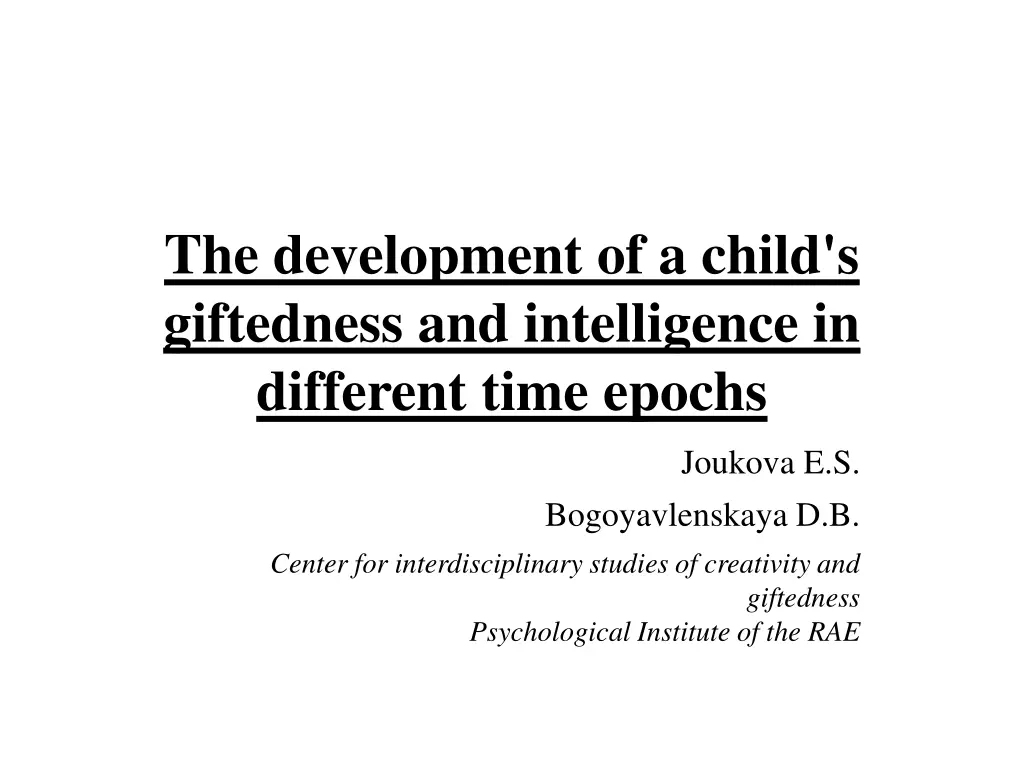
Child Giftedness and Intelligence Development Across Time Epochs
Exploring the impact of changing technological environments on child development, a study compared intelligence and giftedness levels of children across different time periods. Results indicated a shift in the prevalence of intellectual difficulties and giftedness, highlighting the evolving landscape of child development.
Download Presentation

Please find below an Image/Link to download the presentation.
The content on the website is provided AS IS for your information and personal use only. It may not be sold, licensed, or shared on other websites without obtaining consent from the author. If you encounter any issues during the download, it is possible that the publisher has removed the file from their server.
You are allowed to download the files provided on this website for personal or commercial use, subject to the condition that they are used lawfully. All files are the property of their respective owners.
The content on the website is provided AS IS for your information and personal use only. It may not be sold, licensed, or shared on other websites without obtaining consent from the author.
E N D
Presentation Transcript
The development of a child's giftedness and intelligence in different time epochs Joukova E.S. Bogoyavlenskaya D.B. Center for interdisciplinary studies of creativity and giftedness Psychological Institute of the RAE
Relevance Changing the situation of the development of a modern child, based on the rapid development of technologies and their introduction into all spheres of life, sets psychologists the task of studying the impact of new conditions on the development of his personality. Researches conducted within the same educational institution in different time periods allow us to talk about the identified differences.
The purpose of the research On selections with a time difference from 9 to 23 years, the levels of intelligence and giftedness were compared. The level of intelligence was assessed by the success of mastering the way of activity, solving the problem. We define giftedness as the ability to create, which is understood as the development of activities on their own initiative.
Research methods and selection The method "Creative field", presented in the method "Animals in the circus" (Bogoyavlenskaya D.B.) allows us to explore the level of intelligence and giftedness. The selections were groups of children aged 6 and 9 years: preschoolers: in 1997 - 33 people, In 2016 - 61 people, primary school students: in 1999 - 21 people, in 2013 - 53 people, in 2022 19 people.
Main results At preschool age, the group of children with serious difficulties in mastering activities and solving tasks in 1997 made up 5% of the selection with 23% of gifted children. Whereas in 2016, we see an increase in "problem" children up to 26% and a reduction of the phenomena of giftedness up to 5%. In primary school age 23 years ago, only 1% of children cannot master activities, whereas after 14 years and to this day, the percentage of intellectual problems is growing with a clear reduction in the phenomena of giftedness.
Preschoolers Research Giftedness Intelligence (low level) 5% 23% Selection 1 - 1997 26% 5% Selection 2 - 2016
Junior schoolchildren (2nd grade) Research Intelligence (low level) 1% Giftedness 23% Selection 1 - 1999 9 % 21% Selection 2 - 2013 13 % 6 % Selection 3 - 2022
Junior schoolchildren (2nd grade) Research Sensorics (low level) Motor skills (low level) 0% 0% Selection 1 -1999 6% 6% Selection 2 - 2013 12 % 7 % Selection 3 - 2022
Conclusions Comparing the indicators of intellectual development and phenomena of giftedness in different time periods, we see a reduction in the phenomena of giftedness at these ages and growing the number of "problem" children.
Inference The analysis of different time periods shows that the development of giftedness in comparison with 23 years earlier has a negative trend. Compared to the end of the last century, in the 21st century we are seeing an growing the number of children with intellectual problems. It seems to us that the revealed picture of differences may conceal the influence of virtual technologies due to their maximum expansion, which should be considered from the point of view of their competition with the necessary areas of child development, often through the substitution of forms and activities which are necessary for the full-fledged formation of personality.
